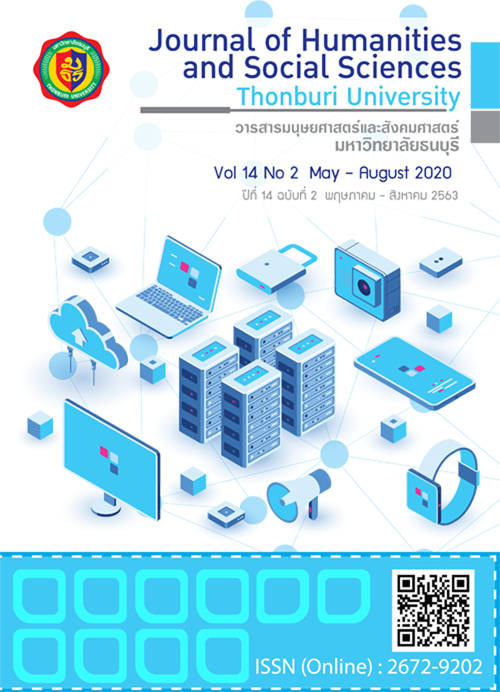The Development of Augmented Reality Manual on Recreation Programming for Church
Keywords:
Augmented reality manual, Recreation programmingAbstract
The purposes of this study were 1) to development of augmented reality manual on recreation programming for church 2) to study the learning achievement from studying the augmented reality manual 3) to study the satisfaction of augmented reality manual. The subjects were 30 recreation readership of Tai Church. They were randomly Selected by Purposive Sampling. The study instruments were 1) the augmented reality manual on recreation programming for church 2) achievement tests 3) the efficiency evaluation forms and 4) the questionnaire of satisfaction. The data were analyzed by using mean, standard deviation and t-test. The results of this research were as follows: 1.) The content experts and media experts evaluated augmented reality manual was in very good quality 2) The augmented reality manual were efficient which based on standard required 80/80 3.) The learning achievement on the augmented reality manual manifested that the post-test score was higher than the pre-test at the statistical significant level of 0.05. 4.) The satisfaction on the augmented reality manual was in very good rank.
References
ญาณวุฒิ ไชยโย;และ วีรพันธุ์ ศิริฤทธิ์. (2560). การพัฒนาหนังสือความจริงเสมือนสามมิติ เรื่อง สมุนไพรจีนสำหรับนักศึกษาระดับปริญญาตรี คณะแพทย์ตะวันออก วิทยาลัยเชียงราย. วารสารวิชาการ Veridian E-Journal สาขามนุษยศาสตร์ สังคมศาสตร์และศิลปะ. 10(1): 471-483.
ถนอมพร เลาหจรัสแสง. (2544). การสอนบนเว็บ (Web-Based Instruction) นวัตกรรมเพื่อคุณภาพการเรียนการสอน. วารสารศึกษาศาสตร์สาร. 28(1): 87-94.
นิพนธ์ บริเวธานันท์. (2560). Augmented Reality. สืบค้นเมื่อ 29 พฤศจิกายน 2560, จากhttp://old.ebooks.in.th/ download/30348/
ประหยัด จิระวรพงศ์. (2553). เทคโนโลยีผสานความจริงเสมือน AR : AUGMENTED REALITY. วารสารศึกษาศาสตร์ มหาวิทยาลัยนเรศวร. 12(3): 189-194
พนิดา ตันศิริ. (2553). โลกเสมือนจริงผสานโลกจริง Augmented Reality. Executive Journal. สืบค้นเมื่อ 29 พฤศจิกายน 2560; จาก http://www.bu.ac.th/knowledgecenter/
รักษพล ธนานุวงศ์. (2556). สื่อเสริมการเรียนรู้โลกเสมือนผสมโลกจริง. วารสาร สสวท. 41 (181): 28-31.
วรลักษณ์ วิทูวินิต; และ จรัญ แสนราช. (2560). การพัฒนาสื่อการสอนมัลติมีเดียเสมือนจริงเรื่องประวัติศาสตร์สถาปัตยกรรม อยุธยา: กรณีศึกษาวัดพระราม. วารสารมนุษยศาสตร์และสังคมศาสตร์ มหาวิทยาลัยราชพฤกษ์. 2(3): 96-108.
วิพงษ์ชัย ร้องขันแก้ว. (2560). โปรแกรมนันทนาการสำหรับคริสตจักร. กรุงเทพฯ: คริสตจักรไท.
ศูนย์การศึกษาต่อเนื่องแห่งจุฬาลงกรณ์มหาวิทยาลัย. (2545). เอกสารประกอบการฝึกอบรมโครงการอบรมโปรแกรมการจัดการหลักสูตร Web Based Instruction (Chula ELS). กรุงเทพฯ: จุฬาลงกรณ์มหาวิทยาลัย.
สุทธิกานต์ บ่อจักรพันธ์ และคณะ. (2559). การพัฒนาสื่อการเรียนการสอนด้วยเทคโนโลยีความจริงเสริมวิชาเคมี เรื่อง แบบจำลองอะตอม สาหรับนักเรียนชั้นมัธยมศึกษาปีที่ 4. การประชุมวิชาการระดับชาติการจัดการเทคโนโลยีและนวัตกรรม ครั้งที่ 2. มหาวิทยาลัยราชภัฏมหาสารคาม วันที่ 30-31 มีนาคม 2559. หน้า 151-157.
สุพจน์ พ่วงศิริ;และ นฤมล เทพนวล. (2559). การพัฒนาคู่มือความจริงเสริม เรื่อง การใช้เครื่องวัดปริมาณไขมันในร่างกายสำหรับนิสิตสาขาวิชาสาธารณสุขศาสตร์ ชั้นปี ที่ 1 คณะพลศึกษา มหาวิทยาลัยศรีนครินทรวิโรฒ. วารสารคณะพลศึกษา. 15(1): 229-241.
J Robert; and Schlatter, Barbara Elwood. (2008). Recreation Programming: Designing Leisure Experiences. 4thed. PA: Sagamore Publishing.
Lee, William;& Owens, Dianal. (2004). Multimedia-Based Instructional Design. 2nded. San Francisco: Pfeiffer.Rossman,
Torkildsen, G. (2005). Leisure and Recreation Management. NY: Routledge.
Translated Thai References
Bariwetanun, N. (2017). Augmented Reality. Retrieved from http://old.ebooks.in.th/download/30348/(in Thai)
Bojukrapan, S; & et al. (2016). The Development of the Instructional Media with Augmented Reality Technology Entitled Atomic Model for Matthayomsuksa 4 Students. The 2nd National Conference on Technology and Innovation Management NCTIM 2016. Rajabhat Maha Sarakham University 30-31 March 2016. P. 151-157. (in Thai)
Chaiyo, Y.;& Siririrth, W. (2017). The Development of Augmented Reality 3D book on the Topic of Chinese Materia Medica for Undergraduate Students of Faculty of Oriental Medicine, Chiang Rai College. Veridian E-Journal, Humanities, Social Sciences and Arts. 10(1): 471-483. (in Thai)
Jiravarapong, B. (2010). AR: Augmented Reality. Journal of Education Naresun University. 12(3): 189-194. (in Thai)
Laohajaratsang, T. (2001). Web-Based Instruction. CMU Journal of Education, 28(1), 87-94. (in Thai)
Phuangsiri, S.;& Thepnuan, N. (2016 )The Development of Augmented Reality Manual on the Use of Body Fat Measurement Tools for First Year Students in Public Health of Faculty of Physical Education, Srinakharinwirot University. Journal of Faculty of Physical Education. 15(1): 229-241. (in Thai)
Rongkhankaew, W. (2017). Recreation Programming for church. Bangkok: Tai church. (in Thai)
Tansiri, P. (2010). Augmented Reality. Executive Journal. Retrieved November 29, 2017, from http://www.bu.ac. th/knowledgecenter/ (in Thai)
Thananuwong, R. (2013). Augmented Reality. Journal of IPST. 41 (181): 28-31. (in Thai)
The Continuing Education Center Chulalongkorn University. (2002). Web Based Instruction (Chula ELS). Bangkok: Chulalongkorn University. (in Thai)
Witoowinit, W.; & Sanrach, C. (2017). The Development of Virtual Reality Multimedia Teching Media on Ayutthaya’s Architecture History: a Case Study of WAT PHRA RAM. Journal of Humanities and Social Sciences, Rajapruk University. 2 (3): 96-108. (in Thai)







